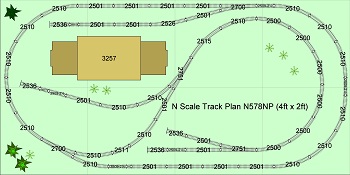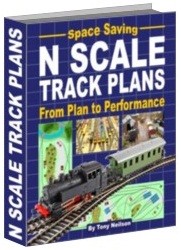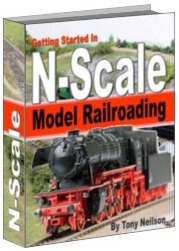Planning Space Allocations For
Your N Scale Model Railroad
Before getting out your woodworking tools it’s time to take a close look at your proposed N scale model railroad layout space. It always seems to be that the space is never big enough for what you have in mind, but this is N-scale and a lot can go into a small space. It’s a matter of focus. Your story is the focus of the N scale railroad, and how much of what goes on around the subject of the story depends on how much space you have and how you use it.
Telling the story in your N scale train layout isn’t the only consideration. Not all of the space you have will be usable for track and scenery. You have to also consider human factors. How high off the floor will the layout be? Does the setup require aisles to get around and work on it? Will it include topography modeling that will rise high above or dive below grade? Will you be the sole train operator, or will there be several people running your model trains? Do you plan to have many visitors?
There are also several different styles of n scale layouts to consider. An island or peninsula layout will allow access on several or all sides. On the other hand, a shelf style layout can fit comfortably in a rather narrow space along one or more walls. Some styles of small n scale layouts lend themselves to certain track arrangements.
Shelf layouts in particular are suitable for end-to-end operation without reversing loops of track for continuous running. If a reversing loop is required, a small shelf layout will have to have a dog bone section at one or both ends to accommodate the curve radius. Island and peninsula layouts are more suitable for reversing loops and continuous running, but they protrude into the available space.
Another interesting arrangement for portability is the modular layout. NTRAK or oNeTRAK modules are created in small standard size units that can be linked together to form huge track runs. Almost any moderately large model train show will include an N scale modular layout. This technique is also seen in HO-scale, but is more prevalent in N-scale. Many model railroading clubs are oriented around this modeling technique. For a modeler who has severely limited space, this is also a means to enjoy the hobby without a permanent layout.

Aisles around the layout are important. Visitors appreciate a wide aisle that will let them get comfortably close to the moving trains and detailed scenery (except for toddlers’ hands!). If you have to work on something on the back of your n scale model train layout, you will appreciate wide aisles even more. On multiple operator layouts wide aisles are an absolute necessity. 36” is usually a minimum. 42” is even better.
Layout height is every bit as important as aisle space. This is always a tradeoff between the perspective from which you want to view the model trains, and the amount of reach you need to be able to conveniently work on the farthest spaces of the railroad. There is really no ‘ideal’ height, but 40” to 52” is common. Most people have a reach of about two feet with the layout between waist and chest height. Placing scenery that needs attention or track that might require re-railing a train beyond that reach is bound to be frustrating. If you can visit a train show, take a tape measure with you and check the height of the display layouts.
Why Make a Sketch Before Building Your N Scale Layout?
Skilled workmen work best from plans. Once you have finished analyzing your space and deciding which style of layout works best for you, sit down with a sheet of paper and a pencil and make a rough sketch of the plan view of your N scale train layout. Sketch in a rough track plan and the industry you are using as the focal point for your scenery. If you plan on simulating actual railroad operations, keep the industry easily accessible so you can couple and uncouple cars and throw manual turnouts conveniently.
Layout design is so absorbing that many potential modelers find themselves stuck in the design phase for months or years as they try to develop some plan that offers the best compromise of track length, physical space, accommodation of modeled industries, scenery, operations, practicality, and investment of time and money to construct it. Some help is available now that pre-computer age modelers were not fortunate enough to have. There are a number of layout software design programs on the market now that make it relatively easy to do a preliminary track design, and then modify it to exactly fit your particular situation and space. Atlas offers a design package based on their own track products that is available for free download. It is a very good basic tool for moving track layout around to fit in a defined space. Other companies offer sophisticated products that not only place track on the model layout, but also provide utilities for creating virtual scenery and rolling stock, and some even allow movement of virtual trains over the virtual layout design. These typically cost in the $50-$100 range and have a rather steep learning curve. For the beginner, a simpler computer program and some actual model railroader building experience show whether an investment in more sophisticated software would be the way to go.
If computer literacy isn’t among your skills, pencil and paper designs can still be made with the use of commercially available templates for curves, turnouts, special track configurations and other layout features. Individually, they cost less than the more sophisticated model train software, but it is possible to spend as much as a full featured design program would cost for a complete set of templates for an advanced design.
The N scale track design book featured on this webpage is perhaps the easiest way to get dozens of interesting track design options without wasting too much time trying to reinvent the wheel. The book of n scale track plans can be downloaded from this website within minutes, and you can save it to your computer for future reference. It includes a big range of small designs including the popular n scale 4×8 layouts, shelf layouts, and a range of track configurations for bigger railroads.
Other Design Considerations for N Scale Layouts
With the preliminary design in hand, it’s time to start to finalize. Here’s where reality will strike!
Two things that take up a lot of space on a layout are yards and curves. Curve radius impacts the kind of rolling stock that will operate reliably and look good when running on the curve. If the curve is to be a reversing loop, it will take up a block of space larger than twice the radius of the curve itself. For example, if a loop is created at the end of the N scale railroad using 18” radius track, the actual loop will need to be about 40-42 inches square to accommodate the track and a reasonable margin. Long passenger cars, automobile carriers, and large or articulated locomotives are notorious for needing large radius curves. If your tastes run to that kind of operation, N-scale offers a very good solution in a reasonable space.
N scale curves:
• Preferred minimum radius 16”
• Conventional radius 13”
• Sharp curve radius 10”
Track of any scale comes in two basic forms. Sectional track is available in fixed length straight sections and fixed radius curved sections. Flexible, or flex-track, comes in longer lengths (three feet is common), and can be easily bent into whatever radius curve or curves you decide to fit into your space. N scale straight sectional track comes in a bewildering assortment of codes and sizes. For example, Atlas offers code 55, 65, and 80 rail straight sections from 5/8” to 6” long. Curved sectional track can be had in radii of 9” up to 71”.
It’s very tempting to try to get as much track as possible into the small design. There’s absolutely nothing wrong with that if having lots of trains on your n scale train layout is your goal. If realism is more to your liking, a simple track design that showcases your trains with dramatic scenery is the way to go.
In some model railroads, a switching yard is either the focus or a key element of interest. Yards occupy a lot of flat space, and a big one can overwhelm a small layout. If you are planning a yard as an element rather than the focus of the operation you’ll need to keep a sense of proportion to the remainder of the train layout. Small yards can be as effective as massive ones. What they lack in drama can be made up for with utility as a way to transfer between lines on a smaller scale and to provide a place where the railroad maintains some kind of maintenance facility. On the other hand, a huge yard is a great way to portray the hustle and bustle of a major traffic hub. Long strings of cars in a classification yard tells visitors that your railroad is the heart of the city!
Many layouts are never really ‘finished’. As you progress in modeling, elements of the N scale model railroad may get modified and replaced as you discover and practice new techniques, or the focus of the operation changes in manner or time. Growing an N-scale layout as a real railroad would grow illustrates a key feature of the scale. Incremental changes that can have a large impact are relatively easy to do in a small space.



